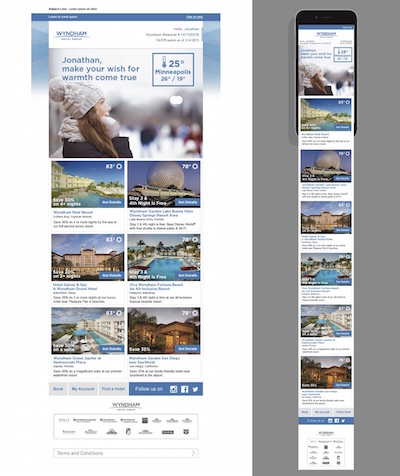Loyalty in the Experience Age
How customer data can drive loyalty through personalized experiences
How customer data can drive loyalty through personalized experiences
Loyalty marketing is quickly changing before our eyes. It’s no longer enough to publish an “earn and burn” loyalty program and expect to create loyal customers. Consumers have a growing expectation that if they provide a brand with personal information, the brand will use it to create a more personalized experience at every touchpoint. This includes (but is not limited to) customer communications, online and mobile experiences, and engagement with a brand’s front-line employees. When done right, these personalized experiences will earn the customer’s trust and ultimately, loyalty.
Many brands have amassed so much data about their customers that they have become paralyzed and struggle to act on it. But by focusing on three key foundations of personalization brands can unlock the power of their data and begin building a deeper relationship with their customers:
Communicate in Context
Segmenting communications based on customer profile, transactions, and browsing behavior has become table stakes. To take relevancy to the next level and personalize communications in real-time, it’s all about context. Contextual marketing leverages data about the customer at the moment of engagement to deliver hyper-relevant content. This may include the current date and time, device data, location data, or even weather data. By leveraging these contextual data points, brands can deliver content that is tailored to the individual customer at the exact moment in time.
A great example of a contextual communication can be seen through the Wyndham Rewards winter promotion email. The responsive email (shown below) used a series of dynamic content blocks driven by IP-based location data to populate the most accurate imagery and weather information at time of open. If a member opened the email in Minneapolis, MN, the email would look very different from one a member opened in Houston, TX. If that member from Minneapolis traveled to Los Angeles the next day and opened the email again, it would dynamically update based on the weather in LA.

The power of contextual data is transforming how brands build personalized communications and experiences for their customers. As technology continues to evolve, opportunities to personalize experiences based on the customer’s context will become more abundant. Brands that take advantage of this rich personalization will stand out from the pack.
Deliver on Preferences
Delivering on consumer preferences is critical. Preferences are what makes each customer unique. When brands are able to personalize an experience based on their preferences, it’s memorable. Identifying customer preferences can be done both implicitly and explicitly. When an airline explicitly asks for a loyalty member’s seat preference at time of enrollment (window vs. aisle), it’s the customer’s expectation that the airline will do their best to offer that seat each time they book.
If a brand hasn’t asked explicitly for a customer’s preferences, they can use customer data (transactions, engagement history, etc.) to implicitly draw conclusions. For example, a restaurant brand can use historical transaction data tied to a customer to offer dish recommendations based on the derived preferences. Many hotel brands train front-line staff to ask questions and observe guests to implicitly derive customer preferences. Staff can record these preferences in a technology solution, and when there is an opportunity to surprise and delight a guest, they can tap into these valuable personal preferences.
Regardless of how customer preferences are captured, when a brand is able to deliver on these preferences through a personalized human experience, it can be unforgettable. It has the power to turn an average customer into a deeply loyal one.
Reward with Exclusivity
Understanding the value of a customer and rewarding them accordingly has been the cornerstone of loyalty marketing for years. In the experience age, the act of rewarding customers has evolved from providing freebies and discounts to exclusive experiences, tailored to the customer, and powered by data. A great example of a brand doing this well is Neiman Marcus. The InCircle program has seven tiered benefit levels based on a customer’s annual spend. For their higher-value customers, circle four and above ($5,000 – $9,999 in spend), the program offers “InCircle Concierge.” The concierge service provides a personalized shopping experience, and can secure one-of-a-kind travel arrangements, dinner reservations at hard-to-get tables, or tickets to concerts or exclusive events not available to the public. This highly personalized experience driven by customer data sets the program apart.
Personalized experiences are the future of loyalty. By using contextual data to improve communication relevance, personalizing based on customer preference, and rewarding best customers with one-of-a-kind experiences, brands can build a level of trust and loyalty that’s tough to break. It’s also important to remember that the core of these personalized experiences is customer data. Brands must consider the technical architecture required to support this level of personalization at scale. For insights on an integrated customer architecture, please visit this previous post.